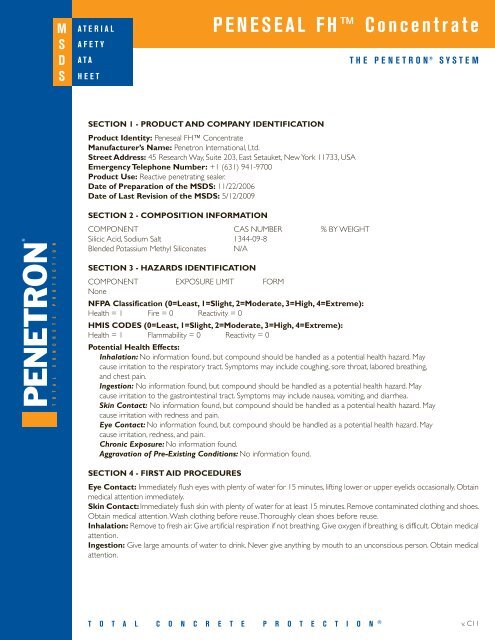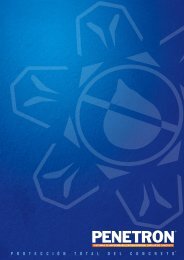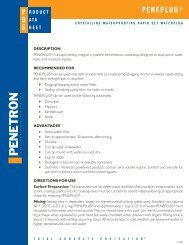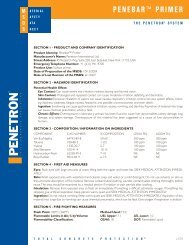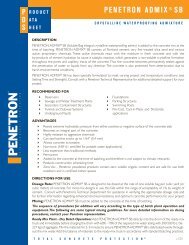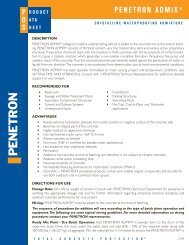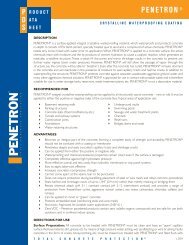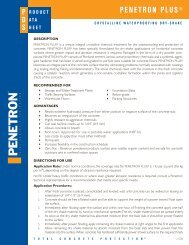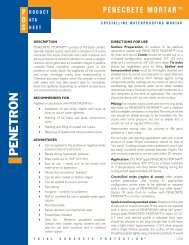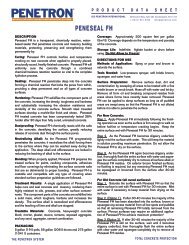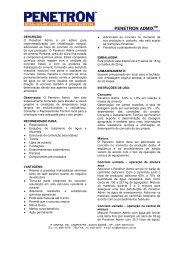MSDS - Penetron
MSDS - Penetron
MSDS - Penetron
Create successful ePaper yourself
Turn your PDF publications into a flip-book with our unique Google optimized e-Paper software.
M<br />
S<br />
D<br />
S<br />
ATERIAL<br />
AFETY<br />
ATA<br />
HEET<br />
PENESEAL FH Concentrate<br />
THE PENETRON ® SYSTEM<br />
®<br />
T O T A L C O N C R E T E P R O T E C T I O N<br />
SECTION 1 - PRODUCT AND COMPANY IDENTIFICATION<br />
Product Identity: Peneseal FH Concentrate<br />
Manufacturer’s Name: <strong>Penetron</strong> International, Ltd.<br />
Street Address: 45 Research Way, Suite 203, East Setauket, New York 11733, USA<br />
Emergency Telephone Number: +1 (631) 941-9700<br />
Product Use: Reactive penetrating sealer.<br />
Date of Preparation of the <strong>MSDS</strong>: 11/22/2006<br />
Date of Last Revision of the <strong>MSDS</strong>: 5/12/2009<br />
SECTION 2 - COMPOSITION INFORMATION<br />
COMPONENT CAS NUMBER % BY WEIGHT<br />
Silicic Acid, Sodium Salt 1344-09-8<br />
Blended Potassium Methyl Siliconates N/A<br />
SECTION 3 - HAZARDS IDENTIFICATION<br />
COMPONENT EXPOSURE LIMIT FORM<br />
None<br />
NFPA Classification (0=Least, 1=Slight, 2=Moderate, 3=High, 4=Extreme):<br />
Health = 1 Fire = 0 Reactivity = 0<br />
HMIS CODES (0=Least, 1=Slight, 2=Moderate, 3=High, 4=Extreme):<br />
Health = 1 Flammability = 0 Reactivity = 0<br />
Potential Health Effects:<br />
Inhalation: No information found, but compound should be handled as a potential health hazard. May<br />
cause irritation to the respiratory tract. Symptoms may include coughing, sore throat, labored breathing,<br />
and chest pain.<br />
Ingestion: No information found, but compound should be handled as a potential health hazard. May<br />
cause irritation to the gastrointestinal tract. Symptoms may include nausea, vomiting, and diarrhea.<br />
Skin Contact: No information found, but compound should be handled as a potential health hazard. May<br />
cause irritation with redness and pain.<br />
Eye Contact: No information found, but compound should be handled as a potential health hazard. May<br />
cause irritation, redness, and pain.<br />
Chronic Exposure: No information found.<br />
Aggravation of Pre-Existing Conditions: No information found.<br />
SECTION 4 - FIRST AID PROCEDURES<br />
Eye Contact: Immediately flush eyes with plenty of water for 15 minutes, lifting lower or upper eyelids occasionally. Obtain<br />
medical attention immediately.<br />
Skin Contact: Immediately flush skin with plenty of water for at least 15 minutes. Remove contaminated clothing and shoes.<br />
Obtain medical attention. Wash clothing before reuse. Thoroughly clean shoes before reuse.<br />
Inhalation: Remove to fresh air. Give artificial respiration if not breathing. Give oxygen if breathing is difficult. Obtain medical<br />
attention.<br />
Ingestion: Give large amounts of water to drink. Never give anything by mouth to an unconscious person. Obtain medical<br />
attention.<br />
T O T A L C O N C R E T E P R O T E C T I O N ®<br />
v. C11
M ATERIAL S AFETY D ATA S HEET<br />
PENESEAL FH Concentrate<br />
THE PENETRON ® SYSTEM<br />
SECTION 5 - FIRE FIGHTING MEASURES<br />
Flash Point: Non-combustible.<br />
Autoignition Temperature: N/A<br />
Flammable Limits in Air: N/A<br />
Extinguishing Media: Alcohol foam, water spray, dry chemical, carbon dioxide.<br />
Extinguishing Media: to Avoid: None.<br />
Special Fire Fighting Procedures: In the event of a fire, wear full protective clothing and NIOSH approved self-contained breathing<br />
apparatus with full facepiece operated in the pressure demand or other positive pressure mode.<br />
“Empty” Container Warning: “Empty” containers retain residue (liquid and/or vapor) and can be dangerous. Do not attempt to<br />
clean since residue can be difficult to remove. “Empty” drums should be completely drained, properly bunged and promptly returned to<br />
a drum reconditioner. All other containers should be disposed of in an environmentally safe manner and in accordance with governmental<br />
regulations. For work on tanks refer to OSHA, ANSI Z 49.1, and other governmental and industrial references pertaining to cleaning,<br />
repairing, welding, or other contemplated operations.<br />
SECTION 6 - ACCIDENTAL RELEASE MEASURES<br />
Large Spills: Evacuate the hazard area of unprotected personnel. Dike and contain with suitable absorbent. Shut off source of leak only<br />
if it is safe to do so. Do not allow to enter sewers or open waterways. Advise authorities if product has entered sewers, waterways, or<br />
extensive land areas.<br />
Small Spills: Take up with absorbent materials such as sand or sawdust and place in non-leaking containers. Dispose of in accordance<br />
with all Federal, state, and local regulations.<br />
SECTION 7 - HANDLING AND STORAGE<br />
Handling: For industrial use only. Avoid skin and eye contact. Minimize breathing vapor or mist. Respiratory protection is required when<br />
ventilation is inadequate. Cleanse skin thoroughly after contact, before breaks and meals, and at the end of a work period. Product is readily<br />
removed from skin by waterless hand cleaners followed by washing thoroughly with soap and water.<br />
Storage: Store in a cool, dry location and in accordance with good industrial practices. Keep containers closed when not in use.<br />
SECTION 8 - EXPOSURE CONTROLS / PERSONAL PROTECTION<br />
Ventilation: Use local exhaust to capture vapor or mists if necessary. Local exhaust is preferred over general exhaust because it can<br />
control the emissions of the contaminant at its source, preventing dispersions into the general work area. Provide ventilation sufficient<br />
to prevent exceeding OSHA PELs.<br />
Respiratory Protection: For emergencies, or instances where the exposure levels are not known, use a full-facepiece positivepressure,<br />
air-supplied respirator.<br />
Skin Protection: Wear impervious protective clothing, including gloves, boots, lab coat, apron, or coveralls, as appropriate to prevent<br />
skin contact.<br />
Eye Protection: Use chemical safety goggles and/or a full face shield where splashing is possible. Maintain eye wash fountain and quickdrench<br />
facilities in work area.<br />
SECTION 9 - PHYSICAL AND CHEMICAL PROPERTIES<br />
Appearance: Clear to hazy liquid.<br />
Odor: Negligible.<br />
Boiling Point: 100ºC<br />
Pour Point: 0ºC<br />
Vapor Pressure (mm Hg): N/A<br />
Vapor Density (Air=1): N/A<br />
Specific Gravity (H2O = 1): 1.2<br />
pH: 11.0-13.0<br />
Solubility in Water: 100%<br />
2<br />
T O T A L C O N C R E T E P R O T E C T I O N ®
M ATERIAL S AFETY D ATA S HEET<br />
PENESEAL FH Concentrate<br />
THE PENETRON ® SYSTEM<br />
SECTION 10 - STABILITY AND REACTIVITY<br />
Chemical Stability: Stable.<br />
Conditions to Avoid: None.<br />
Incompatible Materials: Contact with most metals causes formation of flammable and explosive hydrogen gas. Gels and generates<br />
heat when mixed with acid.<br />
Hazardous Decomposition or By-Products: Hydrogen gas.<br />
Hazardous Polymerization: Will not occur.<br />
SECTION 11 - TOXICOLOGICAL INFORMATION<br />
No LD50/LC50 information is available relating to normal routes of occupational exposure.<br />
Eye Effects: May cause irritation, redness, and pain.<br />
Skin Effects: May cause irritation with redness and pain.<br />
Oral Effects: May cause irritation to the gastrointestinal tract. Symptoms may include nausea, vomiting, and diarrhea.<br />
Inhalation Effects: May cause irritation to the respiratory tract. Symptoms may include coughing, sore throat, labored breathing, and chest<br />
pain.<br />
SECTION 12 - ECOLOGICAL INFORMATION<br />
Environmental Fate: No information available.<br />
Ecotoxicity: No information available.<br />
Further Information: None.<br />
SECTION 13 - DISPOSAL CONSIDERATIONS<br />
When disposed of properly, this product does not meet RCRA classification or listing for hazardous waste. Dispose in accordance with<br />
all applicable Federal, state, provincial, and local environmental regulations. Empty containers should be recycled or disposed of through<br />
an approved waste management facility. Disposal methods identified are for the product as sold. For proper disposal of used material, an<br />
assessment must be completed to determine the proper and permissible waste management options permissible under applicable rules,<br />
regulations and/or laws governing your location.<br />
SECTION 14 - TRANSPORT INFORMATION<br />
DOT Shipping Label: Not regulated by the U.S. DOT.<br />
Hazard Class: Not applicable.<br />
SECTION 15 - REGULATORY INFORMATION<br />
Federal/National: This product is not hazardous as defined by the OSHA Hazard Communication Standard, 29 CFR 1910.1200.<br />
Superfund Amendments and Reauthorization Act of 1986 (SARA), Title III (Emergency Planning and Community<br />
Right to Know Act), Section 313:<br />
This product contains the following substances subject to the reporting requirements of Section 313 of Title III of the<br />
Superfund Amendments and Reauthorization Act of 1986 and 40 CFR Part 372: None<br />
Toxic Substances Control Act (TSCA): All components of this product are on the TSCA Inventory or are exempt from the TSCA<br />
Inventory requirements.<br />
3<br />
T O T A L C O N C R E T E P R O T E C T I O N ®<br />
<strong>Penetron</strong> International, Ltd.<br />
45 Research Way, Suite 203<br />
East Setauket, NY 11733, USA<br />
+1 (631) 941-9700<br />
penetron.com<br />
info@penetron.com


